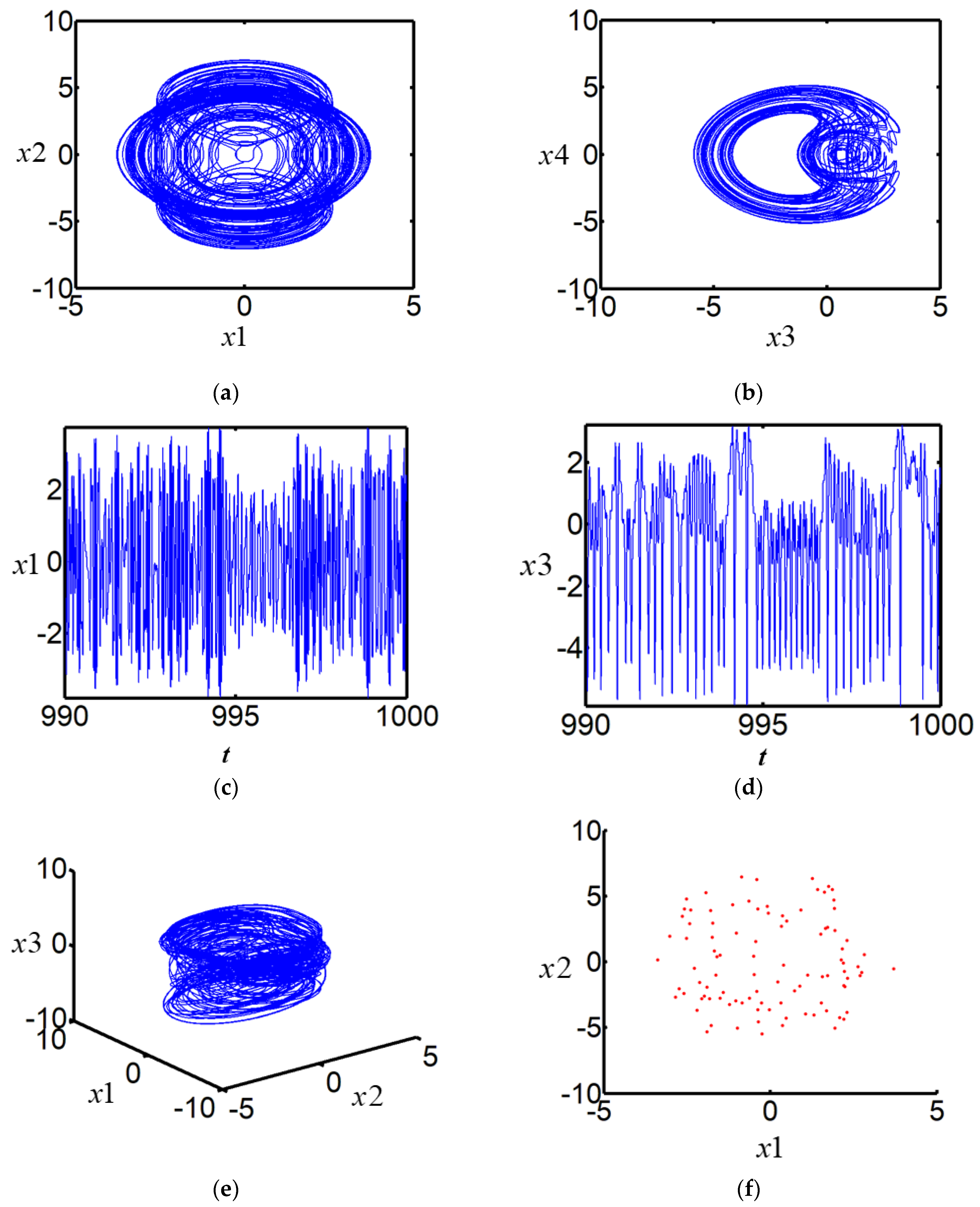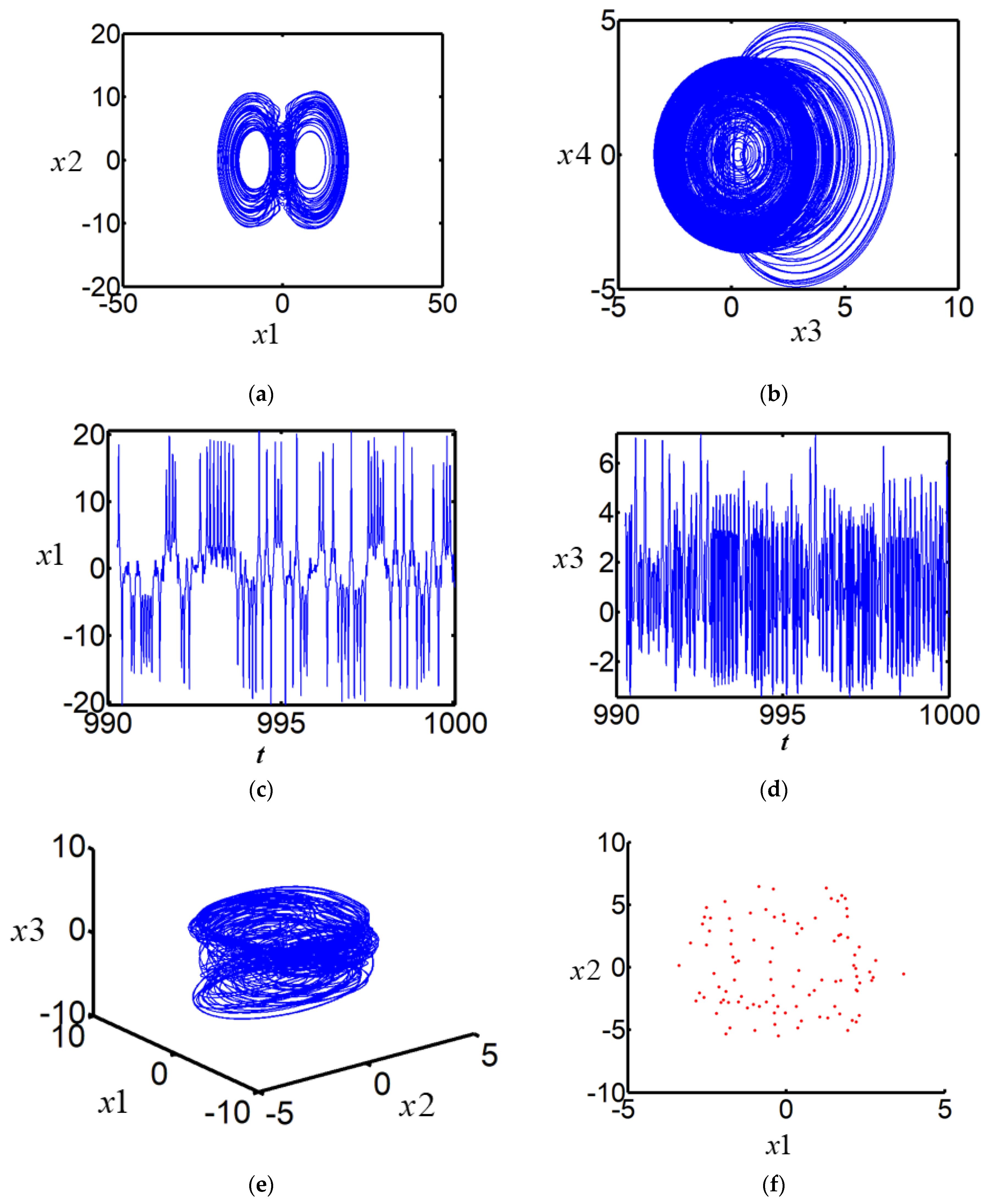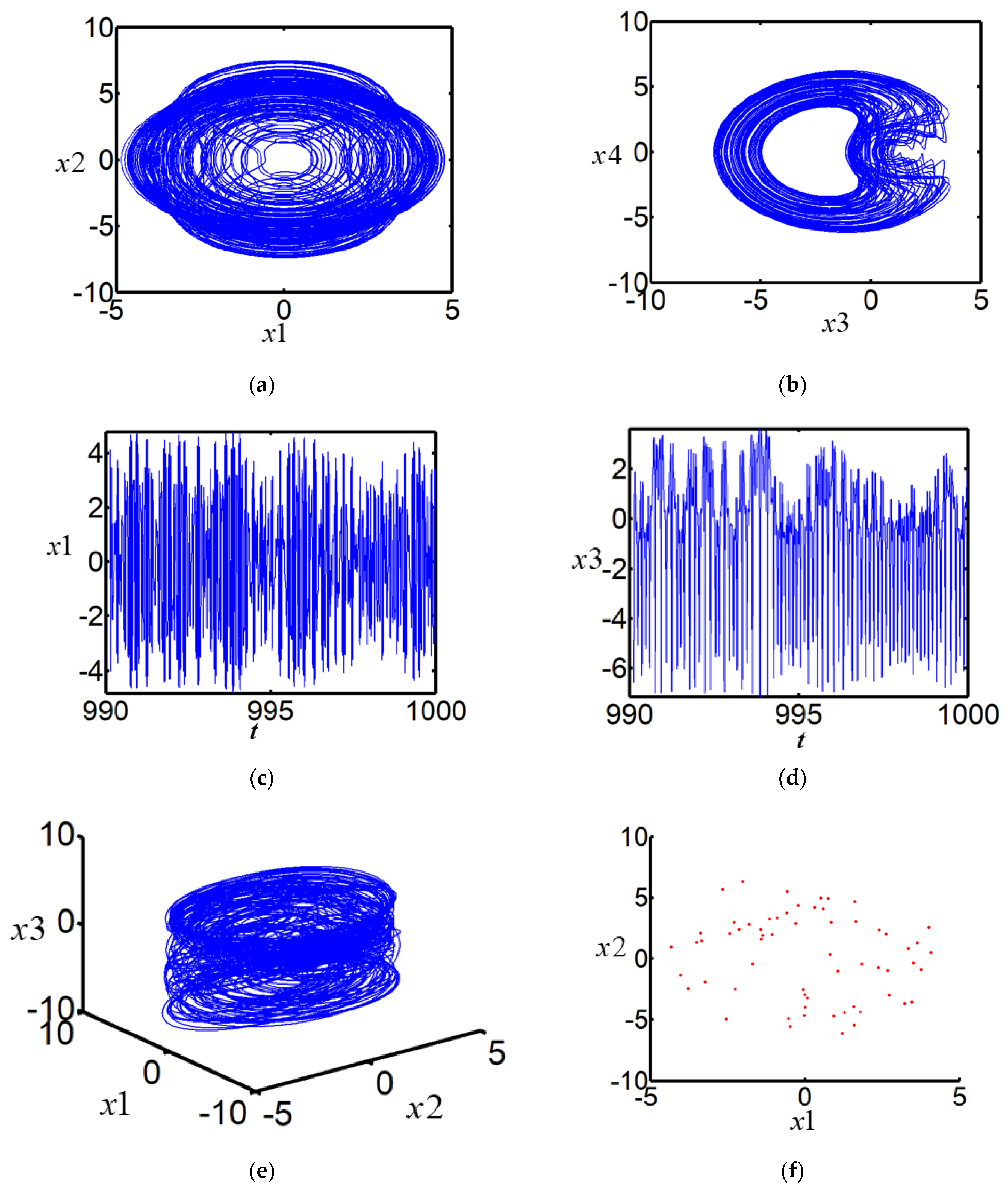Fractal Analysis of Local Activity and Chaotic Motion in Nonlinear Nonplanar Vibrations for Cantilever Beams
Abstract
:1. Introduction
2. Equations of Cantilever Beam
2.1. Solution of Equilibrium Point
2.2. Variational Equation
2.3. Laplace Transform of Variational Equation
2.4. Complex Function
3. Theory of Local Activity
- (i)
- has a zero in .
- (ii)
- has a multiple zero on the imaginary axis.
- (iii)
- If has a simple zero on the imaginary axis, then is either a negative real number or a complex number.
- (iv)
- for some .
3.1. Zeros of Complex Function
3.2. Real Part of Complex Function
4. Results and Discussions of Fractal Chaotic Motion
5. Conclusions
Author Contributions
Funding
Institutional Review Board Statement
Informed Consent Statement
Data Availability Statement
Conflicts of Interest
Abbreviations
| CNN | Convolutional Neural Networks |
| , , , | Real functions |
| Damping coefficient | |
| , | Tuning parameters |
| , , , , | Constants |
| Parametric excitation | |
| , | External excitations |
| Periodic forcing | |
| Jacobian matrix | |
| Equilibrium point | |
| Eigenvalue | |
| Infinitesimal variables | |
| Identity matrix |
References
- Yao, M.H.; Ma, L.; Zhang, W. Study on power generations and dynamic responses of the bistable straight beam and the bistable L-shaped beam. Sci. China-Technol. Sci. 2018, 61, 1404–1416. [Google Scholar] [CrossRef]
- Yao, M.H.; Zhang, W.; Chen, Y.P. Analysis on nonlinear oscillations and resonant responses of a compressor blade. Acta Mech. 2014, 225, 3483–3510. [Google Scholar] [CrossRef]
- Yao, M.H.; Ma, L.; Zhang, W. Nonlinear dynamics of the high-speed rotating plate. Int. J. Aerosp. Eng. 2018, 2018, 5610915. [Google Scholar] [CrossRef] [Green Version]
- Nayfeh, A.H.; Pai, P.F. Non-linear non-planar parametric responses of an inextensional beam. Int. J. Non-Linear Mech. 1989, 24, 139–158. [Google Scholar] [CrossRef]
- Pai, P.F.; Nayfeh, A.H. Non-linear non-planar oscillations of a cantilever beam under lateral base excitations. Int. J. Non-Linear Mech. 1990, 25, 455–474. [Google Scholar] [CrossRef]
- Dwivedy, S.K.; Kar, R.C. Simultaneous combination and 1:3:5 internal resonances in a parametrically excited beam-mass system. Int. J. Non-Linear Mech. 2003, 38, 585–596. [Google Scholar] [CrossRef]
- Young, T.H.; Juan, C.S. Dynamic stability and response of fluttered beams subjected to random follower forces. Int. J. Non-Linear Mech. 2003, 38, 889–901. [Google Scholar] [CrossRef]
- Ma, H.; Zeng, J.; Lang, Z.; Zhang, L.; Guo, Y.; Wen, B. Analysis of the dynamic characteristics of a slant-cracked cantilever beam. Mech. Syst. Signal Process. 2016, 75, 261–279. [Google Scholar] [CrossRef]
- Anderson, T.J.; Nayfeh, A.H.; Balachandran, B. Coupling between high-frequency modes and a low-frequency mode: Theory and experiment. Nonlinear Dyn. 1996, 11, 17–36. [Google Scholar] [CrossRef]
- Cusumano, J.P.; Moon, F.C. Chaotic non-planar vibrations of the thin elastica: Part I: Experimental observation of planar instability. J. Sound Vib. 1995, 179, 185–208. [Google Scholar] [CrossRef]
- Cusumano, J.P.; Moon, F.C. Chaotic non-planar vibrations of the thin elastica: Part II: Derivation and analysis of a low-dimensional model. J. Sound Vib. 1995, 179, 209–226. [Google Scholar] [CrossRef]
- Arafat, H.N.; Nayfeh, A.H.; Chin, C.M. Nonlinear nonplanar dynamics of parametrically excited cantilever beams. Nonlinear Dyn. 1998, 15, 31–61. [Google Scholar] [CrossRef]
- Yao, M.H.; Zhang, W. Multipulse Shilnikov orbits and chaotic dynamics for nonlinear nonplanar motion of a cantilever beam. Int. J. Bifurc. Chaos 2005, 15, 3923–3952. [Google Scholar] [CrossRef]
- Yao, M.H.; Zhang, W. Multi-Pulse chaotic motions of high-dimension nonlinear system for a laminated composite piezoelectric rectangular plate. Meccanica 2014, 49, 365–392. [Google Scholar] [CrossRef]
- Yao, M.H.; Niu, Y.; Hao, Y.X. Nonlinear dynamic responses of rotating pretwisted cylindrical shells. Nonlinear Dyn. 2019, 95, 151–174. [Google Scholar] [CrossRef]
- Yao, M.H.; Chen, Y.P.; Zhang, W. Nonlinear vibrations of blade with varying rotating speed. Nonlinear Dyn. 2012, 68, 487–504. [Google Scholar] [CrossRef]
- Dick, A.J.; Balachandran, B.; Yabuno, H.; Numatsu, M.; Hayashi, K.; Kuroda, M.; Ashida, K. Utilizing nonlinear phenomena to locate grazing in the constrained motion of a cantilever beam. Nonlinear Dyn. 2009, 57, 35–349. [Google Scholar] [CrossRef]
- Yu, Y.P.; Chen, L.H.; Lim, C.W.; Sun, Y.H. Predicting nonlinear dynamic response of internal cantilever beam system on a steadily rotating ring. Appl. Math. Model. 2018, 64, 541–555. [Google Scholar] [CrossRef]
- Francesco, P.P.; Marzia, S.V.B.; Raffaele, B.; Francesco, M.D.S. Random vibrations of stress-driven nonlocal beams with external damping. Meccanica 2020, 56, 1329–1344. [Google Scholar]
- Colgate, J.E.; Schenkel, G.G. Passivity of a class of sampled-data systems: Application to haptic interfaces. J. Robot. Syst. 1997, 14, 37–47. [Google Scholar] [CrossRef]
- Xie, L.; Fu, M.; Li, H. Passivity analysis and passification for uncertain signal processing systems. IEEE Trans. Signal Process. 1998, 46, 2394–2403. [Google Scholar]
- Khan, M.A.; Sahoo, B.; Mondal, A.K. Control of chaos to obtain periodic behaviour via nonlinear control. Proc. Natl. Acad. Sci. India Sect. A-Phys. Sci. 2015, 85, 143–148. [Google Scholar] [CrossRef]
- Pogromsky, A.Y. Passivity based design of synchronizing systems. Int. J. Bifurc. Chaos 1998, 8, 295–319. [Google Scholar] [CrossRef] [Green Version]
- Bemporad, A.; Bianchini, G.; Brogi, F. Passivity analysis and passification of discrete-time hybrid systems. IEEE Trans. Autom. Control 2008, 53, 1004–1009. [Google Scholar] [CrossRef]
- Chua, L.O. Passivity and complexity. IEEE Trans. Circuits Syst. I Fundam. Theory Appl. 1999, 46, 71–82. [Google Scholar] [CrossRef]
- Yang, T.; Chua, L.O. Testing for local activity and edge of chaos. Int. J. Bifurc. Chaos 2001, 11, 1495–1591. [Google Scholar] [CrossRef] [Green Version]
- Chua, L.O. Local activity is the origin of complexity. Int. J. Bifurc. Chaos 2005, 15, 3435–3456. [Google Scholar] [CrossRef] [Green Version]
- Ying, J.J.; Liang, Y.; Wang, J.L.; Dong, Y.J.; Wang, G.Y.; Gu, M.Y. A tristable locally-active memristor and its complex dynamics. Chaos Solitons Fractals 2021, 148, 111038. [Google Scholar] [CrossRef]
- Itoh, M.; Chua, L.O. Oscillations on the edge of chaos via dissipation and diffusion. Int. J. Bifurc. Chaos 2007, 17, 1531–1573. [Google Scholar] [CrossRef]
- Tang, C.; Chen, F.; Wang, J.; Li, X. Extending Local Passivity Theory and Hopf Bifurcation at the Edge of Chaos in Oregonator CNN. Int. J. Bifurc. Chaos 2012, 22, 1250285. [Google Scholar] [CrossRef]
- MatsukI, T.; Shibata, K. Adaptive balancing of exploration and exploitation around the edge of chaos in internal-chaos-based learning. Neural Netw. 2020, 132, 19–29. [Google Scholar] [CrossRef] [PubMed]
- Itoh, M.; Chua, L. Chaotic oscillation via edge of chaos criteria. Int. J. Bifurc. Chaos 2017, 27, 1730035. [Google Scholar] [CrossRef]
- Chua, L.; Sbitnev, V.; Kim, H. Neurons are poised near the edge of chaos. Int. J. Bifurc. Chaos 2012, 22, 1250098. [Google Scholar] [CrossRef]
- Dong, Y.J.; Wang, G.Y.; Chen, G.R.; Shen, Y.R.; Ying, J.J. A bistable nonvolatile locally-active memristor and its complex dynamics. Commun. Nonlinear Sci. Numer. Simul. 2020, 84, 105203. [Google Scholar] [CrossRef]
- Itoh, M. Memristor circuits for simulating nonlinear dynamics and their periodic forcing. Chaotic Dyn. 2019, 19, 07822. [Google Scholar]



Publisher’s Note: MDPI stays neutral with regard to jurisdictional claims in published maps and institutional affiliations. |
© 2022 by the authors. Licensee MDPI, Basel, Switzerland. This article is an open access article distributed under the terms and conditions of the Creative Commons Attribution (CC BY) license (https://creativecommons.org/licenses/by/4.0/).
Share and Cite
Zhang, M.; Kong, P.; Hou, A.; Xu, Y. Fractal Analysis of Local Activity and Chaotic Motion in Nonlinear Nonplanar Vibrations for Cantilever Beams. Fractal Fract. 2022, 6, 181. https://doi.org/10.3390/fractalfract6040181
Zhang M, Kong P, Hou A, Xu Y. Fractal Analysis of Local Activity and Chaotic Motion in Nonlinear Nonplanar Vibrations for Cantilever Beams. Fractal and Fractional. 2022; 6(4):181. https://doi.org/10.3390/fractalfract6040181
Chicago/Turabian StyleZhang, Mingming, Pan Kong, Anping Hou, and Yuru Xu. 2022. "Fractal Analysis of Local Activity and Chaotic Motion in Nonlinear Nonplanar Vibrations for Cantilever Beams" Fractal and Fractional 6, no. 4: 181. https://doi.org/10.3390/fractalfract6040181




